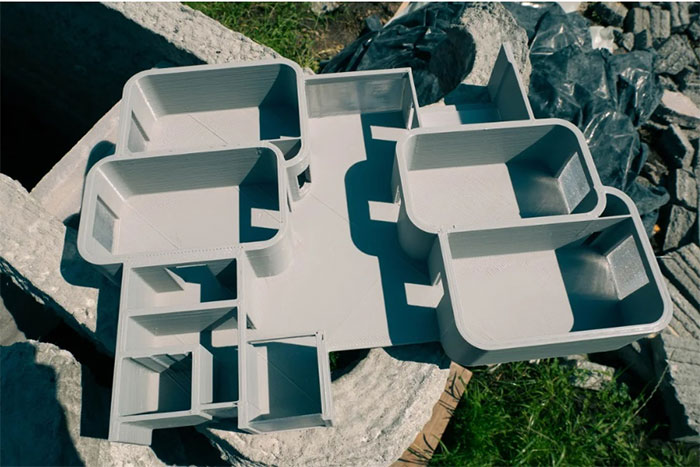3D printing solution to build a school quickly in a war zone
In just 40 hours, the walls of the Lviv primary school pilot project (Ukraine) were completed thanks to a COBOD 3D printer.
According to Jean-Christophe Bonis, founder of Team4UA - the non-profit organization responsible for the pilot project, this is the first 3D printed educational facility in Europe and the first 3D printed building in a war zone .
'I'm not a builder, nor do I want to be an architect or developer. Through robots and artificial intelligence (AI), through technology, we hope to accelerate the construction process ,' Mr. Bonis said in an interview with CNN.

4-classroom school model designed for Lviv primary school. (Photo: Team4UA).
Immediately after Russia conducted a special military operation in Ukraine in February 2022, places in Eastern Ukraine such as Lviv province faced a big problem: how to receive the influx of displaced people here. immigration in numbers reaching tens of thousands of people. According to the latest figures from the United Nations International Organization for Migration, as of December 2023, there were 173,000 people displaced within Ukraine due to fighting.
Mr. Bonis added that the Hive project will build a school equipped with four classrooms to help the school accommodate more students displaced by the war. He hopes that if successful, the project will allow 3D printing technology to become one of the construction tools in Ukraine.
Andriy Zakaliuk - head of the Lviv Department of Education - said the project provides an opportunity to experience a new environment for Ukrainian children. "They will start a new phase of life in a new, modern environment. This is an iconic facility. These children have the opportunity to see that with the help of 3D printers, you can build real buildings".
Challenge power outages and bombings
Experts point out that construction using 3D printing can be significantly faster and more sustainable than traditional construction methods.
Team4UA collaborated with Ukrainian studio Balbek Bureau on the school design and architecture firm Ars Longa on engineering. Construction on the single-storey school started in September 2022 and the entire project, from foundation to completion, was initially expected to take just 3 months.
But airstrikes and bombing across the country throughout October-November 2022 hit critical civilian infrastructure, including the power grid, causing widespread power outages in Lviv, hinder the printer transportation process.
It was not until last summer that the situation in Lviv stabilized and power was fully restored, allowing the printers to go into operation. In less than 2 days, the school's concrete frame was completed.
However, the original plan to open the facility in January 2024 was once again pushed back because of funding problems. Developers need another $400,000.
As a relatively new technology and with limited data on the safety and stability of buildings, 3D printing is mainly used for one-off projects or research collaborations. When it comes to large-scale construction, this technology is still in its infancy. Additionally, although 3D printing has the potential to be cheaper than conventional construction methods, the initial cost of printers can be extremely high and their size can make moving them difficult. difficult and expensive.
According to Christian Lange, Associate Professor of Architecture at the University of Hong Kong, there are cheaper, faster alternatives to 3D printing, such as prefabricated buildings and modules like these models. World War II provided cheap housing for people.

The walls took only 40 hours to complete. Photo: Team4UA
Application of 3D technology
Team4UA is not the only organization that sees the potential of 3D printing in disaster and conflict zones.
CEO of Arizona-based construction company Diamond Age (USA) Jack Oslan said the company is discussing with Ukrainian officials about 3D printing bomb shelters and military infrastructure.
Diamond Age uses a 3D printing system to build insulated walls. This design is 30% more energy efficient than wood-frame structures and is sturdy enough to withstand a Category 5 hurricane or moderate earthquake.
According to a study by the Kiev School of Economics, damage to Ukraine's infrastructure from the conflict as of September 2023 – including homes, schools, energy networks and transport systems – will require about 151.2 billion USD to replace.
Mr. Oslan said 3D printing technology could help Ukraine's reconstruction work. Team4UA hopes the pilot programs can help them increase speed and efficiency while cutting costs on future humanitarian projects.
- Build your house using 3D printing technology without using brick
- Impressed with 3-D nano printers
- HP launched a new professional photo printing solution
- Singapore will create houses for people with 3D printing and assembly technology like Lego
- Students build micro-houses with 3D printing technology in just 1 day
- The first 3D printing office in the world
- Scientists have created 3D printing school meals
- Build a cluster of houses with the world's first 3D printing technology in the Netherlands
- NASA invests in technology to build houses on the moon
- 3D printing houses - solutions to build convenient and cheap houses
- Detects big security flaws in 3D printing technology
- The world's first 3D printing house
 The US company is about to build a supersonic passenger plane of 6,000km / h
The US company is about to build a supersonic passenger plane of 6,000km / h Japan develops avatar robot as in fiction film
Japan develops avatar robot as in fiction film Australia tested the world's first mango picking robot
Australia tested the world's first mango picking robot America develops technology to separate water from animal waste
America develops technology to separate water from animal waste